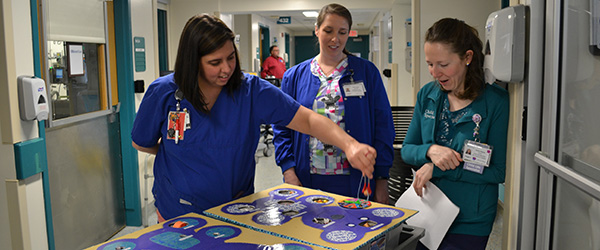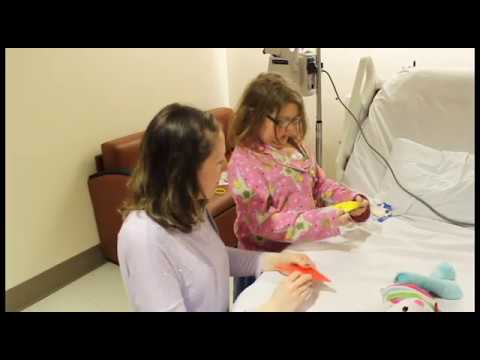Child Life specialists help kids have fun during hospital stay

When a 10-year-old girl arrived at Kentucky Children’s Hospital for a routine appendectomy, she asked a series of anxious questions. Would she be able to feel the surgery? Would it hurt? What if she woke up in the middle of it?
Then Sarah McAlister arrived and calmly demonstrated everything the girl could expect before the surgery, including the stickers and leads, the anesthesia mask, and the other steps that would occur until the girl went to sleep on the operating table.
“As we were talking,” McAlister said, “she was calmer, happier and engaged again.”
McAlister is one of KCH’s Child Life specialists, a group of professionals dedicated to helping young patients and their families understand and cope with the stresses of illness and injury.
“We prepare, educate, support, distract and play with kids in the hospital,” said Ashley Rapske, another Child Life specialist at KCH. “We help them positively cope with being here, and help them understand what’s happening and why.”
More than playtime
Children process the world differently than adults, and traumatic stress or injury can inhibit their ability to cope and heal. Without the intervention of a certified professional, the pain, confusion, stress and fear can have a lasting effect on their development.
Child Life specialists work closely with doctors, nurses, social workers and family members to implement a child’s health plan and help them reach their treatment goals. To a child, this can look and feel like playtime, which helps alleviate stress and assuage fear.
“Play is not just a thing that you do – it’s how kids learn, process and understand the world around them,” McAlister said. “You may think, ‘Oh, they’re just building something cool with Legos,’ but we’re also working on fine motor skills. Or if they are chasing bubbles down the hall, they’re working on gross motor skills and breathing.”
“We use the things the patient likes and tie that into their therapy,” Rapske said. “So if they need to walk, what can we do to help them walk? Can we have a dance party, a bubble-popping party, or get a remote-control car? Or if they need to eat or drink, we could have a tea party. Or play Candyland, and every time you get a red card you take two bites of your pudding.”
Helping kids feel comfortable in the hospital
The child life profession has existed since the 1920s. In 1982, standards of practice were drafted for the organization that became the Association of Child Life Professionals.
Certification is rigorous; a trainee must complete a 600-hour internship before taking an exam. After certification, specialists are required to complete 60 hours of professional development courses every five years.
These requirements are in addition to a bachelor’s degree. McAlister has a degree in family and child studies with a concentration in child life, and Rapske studied human development and family sciences with an emphasis in child development.
The services of a Child Life specialist can go beyond the hospital setting. Recently, the third-grade class of Pikeville Elementary School sent a Flat Stanley to KCH. The Child Life specialists and nurses used it as an opportunity to educate children about what happens in a hospital.
“We treated Stanley as though he had a broken leg,” said Erin McAnallen, an expressive arts resource specialist who works with the Child Life staff on art and creative projects for the patients. “We bandaged him up and took pictures of him interacting with the nurses, playing in the playroom and having fun at the hospital. We really wanted to clear up the misconception that hospitals are scary places, and let kids know that this is a place of help and healing.”
The ‘I did it’ moments
In addition to helping children understand their treatment, the team works hard to make patients’ hospital stays fun. Throughout the year, they organize events around holidays so that patients don’t feel as though they are missing anything. Events include trick-or-treating at Halloween, a visit with Santa at Christmas and an Easter egg hunt.
During the Olympics, staff organized events such as “cart curling” and “snow ball toss.”
“Our team is made up of dedicated and passionate specialists and patient activity assistants,” said Child Life Coordinator Jennifer Guilliams. “They have the extraordinary ability to give patients and families the tools need to understand, master, and positively cope with the challenges they face during their medical treatments.”
A Child Life specialist’s day isn’t always games and crafts. Sometimes they are called upon to help a patient have opportunities and experiences they wouldn’t otherwise have. McAlister recalls a terminally ill patient who was sad that she never got to go to the beach. So the staff brought the beach to her.
“We had sand and shells, smells of the beach and a virtual-reality set so she could feel like she was really there,” McAlister said. “Even though it was a really sad experience, we helped that patient reach one of her goals in life.”
From the trying to the triumphant, the specialists take great pride in seeing their patients overcome their fear and anxiety and use those coping skills even after they leave the hospital.
“For me, it’s the ‘I did it’ moments,” Rapske said. “Seeing a child go from hiding in the corner to coping with their treatment. To have a child say ‘I understand, I’m not scared. I can do this, look what I did,’ and getting them from one point to another in their journey, is really great.”





